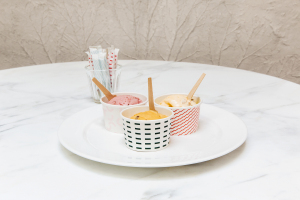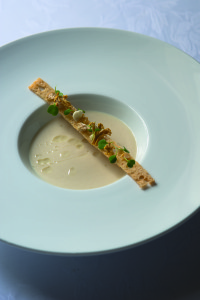Not sure if St Brigid’s day is celebrated in every school in Ireland but many of our local national schools teach the children how to make the Crois BrÃde or St. Brigids’s cross.
Like many of our saints including St Patrick, there seems to be considerable confusion about the background facts, nonetheless I’ve always loved St. Brigid whom I understood was the patron saint of dairy.
Every year, children’s nimble fingers weave green rushes into the little cross while listening to the colourful story of Ireland’s female patron saint, Bridget, who was born in 451 in Faughart, near Dundalk, County Louth. The story goes that she converted a pagan chief in his last hours by explaining the story of Christianity as she wove a little cross from the reeds that were strewn on the bedroom floor (as was the custom then, circa 500A.D.).
The children’s St. Brigid’s crosses are stuffed into school bags and proudly presented to Mum and Dad to bless the house and/or cow byre because this gentle saint was said to have loved cows who gave a prodigious amount of milk which she distributed to the poor.
Here at the Ballymaloe Cookery School we still continue the tradition every year and our neighbour Mrs Cowhig comes to the cookery school to teach the students how to make Crois BrÃde, (this term there are twelve nationalities,  Irish and UK of course, US, Canadian, Japanese, Russian, Dutch, German, Norwegian, Australian…..).
Milk is a magical ingredient with infinite possibilities – the ultimate ‘fridge staple’. It can be transformed into numerous milk products. Every country has its own traditions and Ireland was for ever famous for the quality and variety of its bán bia (or white meats, as dairy products are known in Gaelic) not surprising because we can grow grass like virtually nowhere else in the world except perhaps New Zealand.
From 1759 to 1870, the biggest butter market in the world was in Cork and butter from the small farms of Cork County was exported as far away as India and the Caribbean. Can you imagine, and that was long before the days of refrigeration – it’s all about the quality. The whole fascinating story has been told in a recently published book “Butter in Ireland, From Earliest Times to the 21st Centuryâ€, editors Peter Foynes, Colin Rynne and Chris Synnott, cost €15, available from www.corkbutter.museum.
If you would like to learn how to make butter, yoghurt, labne, paneer and lots of simple cheeses, check out the Ballymaloe Cookery School website www.cookingisfun.ie for the next dates . Meanwhile have fun with these recipes using milk and milk products. Learn and pass on the skill of making a Cros BrÃde and continue our Irish traditions.
Soft Yoghurt Cheese – Labne
This thick, creamy, soft cheese from the Middle East is an easy way to dabble in cheesemaking and is wonderfully versatile. It can be used for sweet or savoury dishes.
Use whole-milk yogurt for a creamier cheese – this can be made from cow’s, sheep’s or goat’s milk. You can also use a top quality commercial yogurt like Glenilen or Killowen.
Makes 500g (18oz) labne
1kg (2 1â„4lb) natural yoghurt
Line a strainer with a double thickness of sterilised cheesecloth. Place it over a bowl. Pour in the yogurt. Tie the four corners of the cheesecloth to make a loose bundle and suspend this bag of yogurt over a bowl. Leave it in a cool place to drip into the bowl for 8 hours. Then remove the cheesecloth and put the labne in a bowl. Refrigerate overnight, and store until needed in a covered glass or plastic container. It will keep for four of five days in the fridge. The liquid whey that has drained off can be used for fermented dishes or to feed to hens or pigs if you have them.
Delicious served with dates, toasted hazelnuts, rose petals and pomegranate seeds see photograph.
It can also be eaten with berries or a kumquat compote and grated chocolate or simply add freshly chopped herbs and a little crushed garlic and serve with homemade cheese biscuits.
Figs with Labne, Sumac, Pistachio and Extra Virgin Olive Oil
Â
Serves 4 as a starter
8 fresh figs in season
8 tablespoons labne
2 teaspoons fresh sumac
3 – 4 teaspoons pistachios, halved
extra virgin olive oil
2 teaspoons honey
a few flakes of sea salt
Spoon two – three tablespoons of labne onto each plate. Cut the figs into quarters, push gently down into the yoghurt. Sprinkle with sumac and pistachios, drizzle with extra virgin olive oil and honey, serve.
Pork Cooked In Milk
Cooking pork in milk produces the most delicious curdy liquid. There is honestly no point in attempting this recipe if you cannot find really good free-range pork. The lactic acid in milk has a tenderising and moistening effect on meat. This recipe is of Italian origin where they also cook veal and chicken in milk on occasions. By the way this is also great with a whole chicken.
Â
Serves 10-12
1.8kg (4lb) loin of pork (free-range and organic if possible)
a dash of extra virgin olive oil
sea salt and freshly ground pepper
600ml (20fl oz/1 pint) milk approximately
thinly sliced peel from 1 lemon, unwaxed
1 teaspoon of slightly crushed coriander seeds or a small handful of fresh sage leaves
4 cloves garlic, cut in half
sprig of marjoram
Remove the rind and almost every scrap of fat. Season generously with sea salt and freshly cracked pepper. Heat a few tablespoons of olive oil in a casserole, large enough to fit the pork. Brown the pork well on all sides, remove to a plate and pour off all the oil and fat. Add the lemon peel, coriander seeds and garlic. Return the pork to the saucepan, add the milk, it should come about half way up the meat. Add a sprig of marjoram or sage and bring to the boil and simmer for 1 1/2-2 hours with the pan partially covered – after about an hour the milk will have formed a golden skin. Scrape all this and what has stuck to the sides back into the milk, continue to cook uncovered.
The liquid should simmer very gently all the time. The whole object of this exercise is to allow the milk to reduce and form delicious, pale coffee-coloured “curds†and a golden crust while the meat cooks. When the pork is cooked slice the meat and carefully spoon the precious curds over the top.
Earl Grey Milk Jam
I found this recipe from Angel Kim in the Cook supplement of the Guardian.
“This is one of the most delicious things I have made. The jam is full of milky, caramel goodness with a faint hint of Earl Grey tea. Spoon it directly out of the jar or drizzle it over pancakes, waffles or ice-cream.â€
Makes 200ml
2 Earl Grey tea-bags
250ml (9floz) whole milk
3tablespoons sugar or vanilla sugar
1 tablespoons honey
a pinch of salt
250ml (9floz) single cream
40g (1½ oz) butter, cubed
Bring the milk to a simmer in a saucepan over a gentle heat. Remove from the heat, add the teabags, steep for about 10 minutes, then remove.
In a large frying pan or non-stick saucepan with high sides, bring the infused milk, sugar, honey and salt to a gentle simmer. Stir until the sugar has dissolved.
Add the cream to the pan in three stages, stirring constantly until it has been incorporated.
Add the butter, stirring until melted. Simmer the sauce over a medium heat for about 20 minutes, stirring frequently to prevent sticking.
Once the jam has thickened and turned slightly darker in colour, simmer for 10-15 minutes longer. It will thicken further once cooled.
Pour into a hot sterilised jar or airtight container then seal with the lid to prevent a skin from forming. Keep in the fridge for up to 5 days.
Â
French Toast
French toast is so good that you forget how economical it is. The French don’t call this French toast. They call it pain perdu or “lost breadâ€, because it is a way to use up leftover bread you would otherwise lose – the only bread you’ve got on the baker’s day off. French toast is actually better if the bread is a little old or sliced and dried out overnight.
Serves 4
3 free range eggs
175ml (6 flozs/3/4 cup) whole milk- not low fat
tiny pinch of salt
6 slices white or light wholemeal bread
4 tablespoons (4 American tablespoons + 4 teaspoons) clarified butter (see below)
Whisk the eggs, milk and salt together until well blended. Strain the mixture into a shallow bowl in which you can easily soak the bread. Dip both sides of each slice of bread in the batter. Melt 2 tablespoons of the butter in a frying pan. Fry the bread over a medium heat until very lightly browned, turning once. Serve warm sprinkled with icing sugar.
To Serve
1) Serve with crispy streaky rashers and a drizzle of maple syrup or honey.
2) Also delicious with sliced strawberries, raspberries, blueberries or grated apple.
3) Serve with a blob of sweet apple sauce.
Variations
Spiced French Toast: Add 1/2 teaspoon cinnamon or nutmeg to the batter.
Lemon or Orange French Toast: Add 2 teaspoons grated lemon or orange zest to the batter
Kheer with Saffron and Pistachio nuts
Kheer is a traditional Indian dessert made from rice, milk and sugar and flavoured with spices. You could garnish it with sultanas, raisins, hazelnuts, pistachios or any nuts of your choice.
Serves 6-8
100g (3½ oz) long-grain rice, such as Basmati
1 litre (1¾ pints) whole milk
a pinch of saffron strands
1 teaspoon of freshly ground cardamom
40g (1½ oz) flaked, toasted almonds
55g  (2½ oz) sugar or a little more to taste
Garnish:
Coarsely chopped pistachios or your choice of toasted nuts and dried fruit.
Soak the rice in cold water for 30 minutes. Drain and then set aside.
Pour the milk into a stainless steel saucepan, bring to a gentle simmer over a medium heat.
Add the rice, stir to combine, then add the saffron, ground cardamom and the flaked almonds. Simmer until the rice has cooked and the milk has reduced by half – around 25-30 minutes.
Stir regularly to make sure the rice doesn’t stick to the bottom of the saucepan.
Add the sugar to taste and stir to dissolve. Pour into a serving bowl or individual dishes. Top with your choice of chopped nuts and dried fruit.
Â
Hot Tips:
Slow Food Galway is celebrating St. Brigit’s Day with a Gourmet Banquet on Sunday February 1st at 5pm, in LOAM Restaurant, Fairgreen, Galway with Michelin Star Chef, Enda McEvoy.
Reception with canapés and wine, five course banquet with Slow Wines and musical entertainment. All proceeds to: Clowns without Borders Ireland; Cope Community Catering, Galway and Slow Food 10,000 Gardens in Africa. Tickets are €75 Euro Contact Eileen: 086-8533395, Kate: 087-9312333 or Cait: 087-2311580.
Give your loved one the gift of a lifetime. Why not impress your Valentine with a Ballymaloe Cookery School voucher which can be tailored in a number of ways to create the perfect gift for the food lover or gardening enthusiast in your life! For more information and to purchase a vouchers see www.cookingisfun.ie or phone 021 4646785
Deasy’s Harbour Bar & Seafood Restaurant in Ring. How lovely is it to have a little black book full of addresses of good places to eat around the country. If Deasy’s in Ring, just a mile from Clonakilty is not already on your radar add it to your list right away. Caitlin Ruth is a beautiful cook. We had a really good dinner there recently with particularly memorable Korean fish cakes, Radicchio with whipped Toonsbridge ricotta and pickled green beans, monkfish with braised fennel, black rice and smoked chilli oil, and hazelnut cake, but there were appreciative sounds coming from all around the table to a variety of other dishes. Phone 023 883 5741



